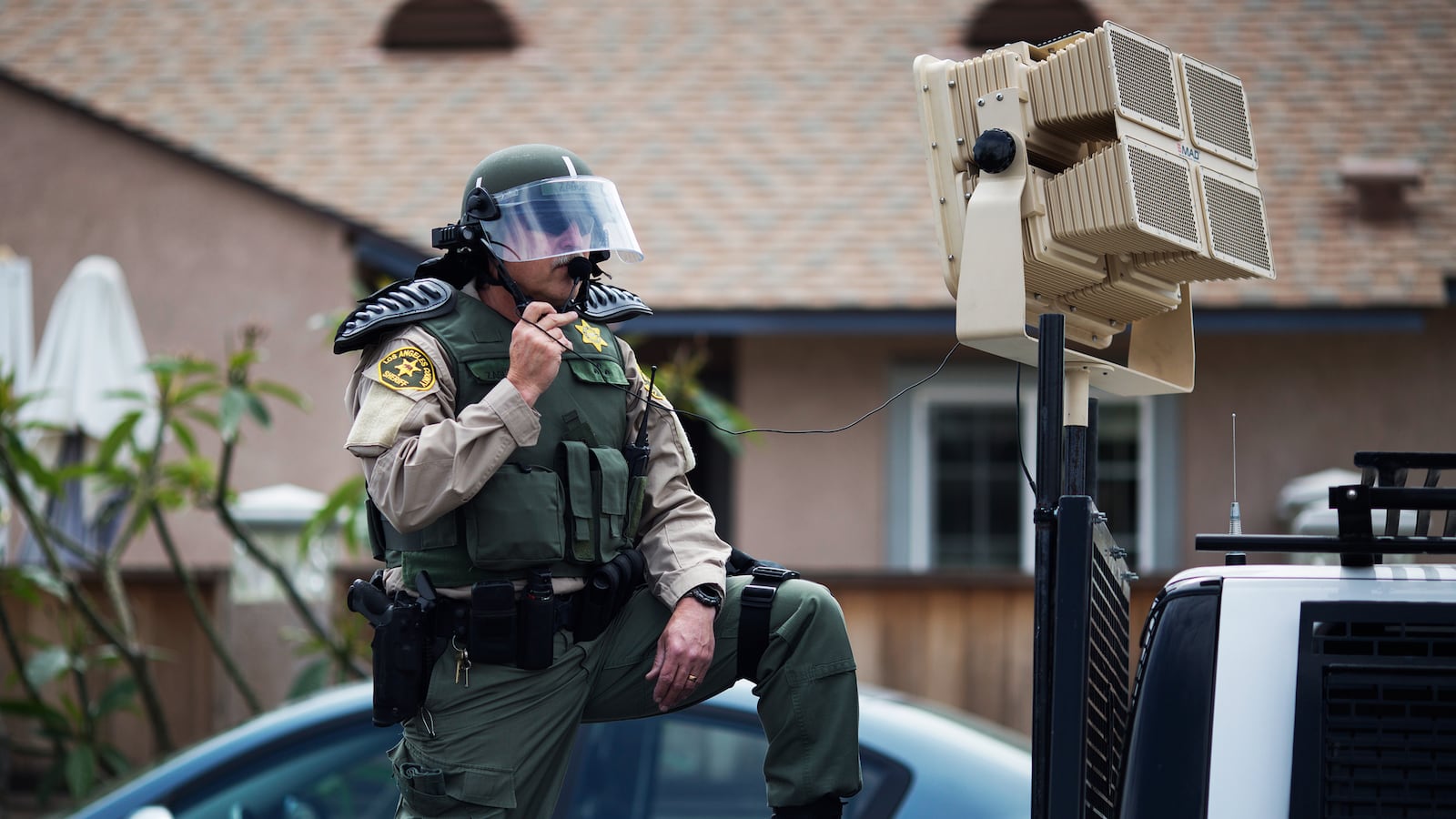Originally developed to ward off pirates at sea, one powerful military-grade device has become a favorite tool for U.S. law enforcement. But with no supervision to speak of, these off-label uses are creating controversy and wreaking havoc on the health of those unlucky enough to be within earshot.
The LRAD (generally pronounced “L-rad,” short for Long Range Acoustic Device) is a brand-name targeted loudspeaker that sends clear announcements and warnings as far as 5,500 meters—about the width of the Hudson River plus Manhattan in some places.
For the U.S. Army, this is a boon to communication in the field. But others regard it as a dangerous sonic weapon.
According to Steve Elliott, project officer of Combat Armaments and Protection Systems of the U.S. Army, soldiers can use LRADs to warn people away from base perimeters in Afghanistan, or to ward off potential car bombers in Iraq. During Haiti’s 2010 earthquake-relief efforts, LRADs were used to direct ships in and out of the main port, said Jeff Drobik, engineering team lead at the Army’s Combat Capabilities Development Command Armament Center.
“The big capability is… communication at some standoff distance where neither side—neither the Army nor the people they’re trying to communicate with—feel like they present a heightened threat to one another,” Elliott said in an interview with The Daily Beast.
The Army is a repeat customer of the San Diego-based LRAD Corp. In August, Elliott’s team put in a $14.8 million contract for devices, which is the company’s largest domestic order since the system was invented in 2003. By next year, the Army is hoping to send 2,434 LRADs abroad, according to Elliott. The devices start at $30,000 apiece for smaller models.
“The Army would like us to issue them faster than we can buy them,” said Elliott.
MILITARY ROOTS
LRAD Corp.’s other clients include the U.S. Navy, the National Guard, and the U.S. Air Force. FEMA once used the device during an infrastructure project. Miners have used the warning system to deter birds from endangering themselves on work sites. In Mill Valley, California, the fire chief recently installed LRADs and a cloud-based software system so that in the event of a disaster, warnings won’t depend on standard communication lines.
Yet, as LRADs flood the market and trickle down from the U.S. Army to municipal law-enforcement agencies across the country, they’ve made headlines as devices used to control people—a use case that can come with some dangerous side effects.
Much to its creator’s chagrin, the media coined the term “sound cannon” to capture the device’s non-military applications. Despite assurances from its creator and police departments that the LRAD is not a weapon, misusing these devices can result in serious hearing damage—and there is nothing stopping law enforcement in many municipalities from doing so.
The LRAD—which looks like a speaker typically mounted on an armored vehicle—directs acoustic energy toward a target. According to the manufacturer’s white paper, sound is deployed in a conical field emanating from the device, and is optimized to the 1 to 5 kHz range, where human hearing is most sensitive. Once you’re within the cone of sound, the closer you get to the device, the louder and more dangerous the situation becomes, according to independent studies and lawsuits.
“We give [soldiers] publications, operating manuals, and training materials and make sure they understand the hazards,” said Elliott. “We don’t allow anyone to come within 75 meters of the ‘red zone.’ We specify when to wear hearing protection, and that behind the speaker you’re in the green zone—we verify those performance characteristics through specific safety testing and measure against published Army standards for sound exposure… [soldiers] are not indiscriminately exposing bystanders. They point it at the intended audience.”
Users can engage two main modes on the LRAD: the “voice” function, which allows speakers to communicate at 20-30 decibels higher than an average loudspeaker, and the “alert” function, which emits high-decibel, highly focused, narrow frequency chirping sounds. LRADs cut through background noise of 88 decibels, according to the manufacturer website, which is about the volume of a freight train 15 meters away.
“The warning tones are very attention-getting,” said Elliott. “If you get close enough at the right volume level, you will definitely feel it. It will make you stop and decide what you want to do next.”
According to LRAD’s website: “In uncertain or escalated public safety situations, LRAD fills the critical gap between the limited range and poor intelligibility of bullhorns and vehicle P.A. systems, and kinetic measures including tear gas projectiles, rubber bullets, pepper balls, Tasers, and flash bang grenades.” Then written in bold: “LRAD is not a weapon; LRAD is a highly intelligible long-range communication system and a safer alternative to non-lethal or kinetic force.”
‘INTENSE PAIN’
The New York Police Department, which was the first known PD to deploy LRADs for crowd-control in 2004, agreed with LRAD’s tenets in a statement to The Daily Beast.
“A specialized unit in the NYPD uses this device in accordance with manufacturer’s specifications during emergency evacuations, and for the purpose of crowd-control,” said Sgt. Jessica McRorie, public information spokesperson for the NYPD. “This is a safe and effective communication tool.”
The NYPD is being sued by six plaintiffs who claim they were assaulted by an LRAD during a 2014 protest in Manhattan in support of Eric Garner. In the lawsuit, the plaintiffs claim that two officers sustained the “deterrent” or “alert” mode continuously for 15 to 20 minutes on targets who were within 10 feet of the device.
According to the suit, the plaintiffs suffered intense pain, permanent tinnitus, migraines, dizziness, confusion, and vertigo. One plaintiff claimed that he was temporarily blinded from the officers’ pepper spray, rendering him helpless to get away from the LRAD. The sonic pressure from the device pushed a bone in his ear inward, impacting and damaging a nerve in his ear, according to the lawsuit.
“It’s midtown Manhattan. There are a lot of people not even necessarily participating in the protest,” said the plaintiffs’ lawyer Gideon Oliver in an interview with The Daily Beast. “...[The NYPD is frequently sued for excessive force… Unfortunately this is not an aberration. These lawsuits always shine a light on what kind of policies police departments should have in place. For LRADs the NYPD position is: You use them like bullhorns, so you can’t hurt anyone with them.”
Some plaintiffs claimed they had trouble working in their respective professions, including photojournalism in crowded areas, since the incident, according to the lawsuit. The case is in discovery through next spring, when it will be presented in district court.
LRAD’s website condemns “erroneous reports” that suggest the device may cause “nausea or disorientation.”
NO OVERSIGHT
Unlike within the military, there are no overarching guidelines on LRAD usage for police departments in the U.S., and no coherent federal records on police purchases, training, and usage. The LRAD “alert” mode has been deployed in everything from crowd control during the Ferguson riots to deterring speeding drivers by blasting them with sound to the Dakota Access Pipeline protests, where a Lakota grandmother reported irreversible hearing damage among the elderly population.
Uses of the LRAD vary. In North Carolina, the Greensboro Police Department told The Daily Beast that officers avoid the alert mode entirely, and only use LRADs to announce themselves before implementing a search warrant, or to call out to a barricaded individual or suspect.
“The sound travels in a forward direction rather than 360 degrees, making it more efficient to get the attention of the suspect, especially if they are in a larger or deeper structure,” said Ronald Glenn, public information officer at the Greensboro PD. “Because of our limited use of the device, we do not have a policy or guideline for using it because it is basically a PA system. It does have the capability for tones and sounds, but we do not use them.”
LRADs were invented in 2003 as a U.S. military communication device in response to the terrorist attack on the USS Cole in Yemen. Elliott said the Army’s watercraft fleet has used LRADs to communicate with other boats, and to warn off pirates.
The NYPD first acquired them through the 1033 program, which allows municipalities to purchase unused federal military supplies—everything from toilet paper to ammunition. The first known public U.S. appearance of an LRAD was during the 2004 Republican National Convention, when the NYPD purchased two units at $35,000 apiece.
In 2009, Karen Piper was a visiting professor at Carnegie Mellon University when she stopped by a protest of the G-20 summit out of curiosity. According to Piper, the Pittsburgh Police Department blasted an LRAD at close range from an armored car for three minutes straight. She said she couldn’t run away because she was stuck in the crowd.
“It really hurts your ears,” said Piper during an interview with The Daily Beast. “I felt sort of nauseous and deafened. I thought I had ruptured an eardrum because of how much it hurt in one ear.”
Piper sued the Pittsburgh Police Department and received a $72,000 settlement, according to the official agreement. The department also agreed to instate guidelines for LRAD use. A handful of police departments followed suit by instituting guidelines of their own, including Massachusetts State Police and the Chicago PD. According to documents acquired by Oliver’s team via a FOIA request, the NYPD devised some LRAD training materials after the 2014 protest incident, but an NYPD spokesperson did not respond when asked to elaborate on the training processes.
Since the Pittsburgh protest, Piper says she’s still unable to hear certain frequencies.
“I’d say I’m happy with the settlement, but I’d rather have my hearing back,” Piper said. “People should sue anytime they use that thing on them… they should just take out that screaming function that ruins people’s hearing.”
In 2010, an independent study by Canada’s Ministry of Community Safety and Correctional Services confirmed that LRADs are dangerous when misused. The study’s recommendations included a strict system of minimum distances from targets, as well as regimented training for authorized users, and minimizing the “alert” mode. The Mounties only use LRADs for marine purposes, not for crowd-control, while the Vancouver Police have banned the “alert” mode altogether. To this day, the Canadian study is the only comprehensive, independent, publicly available review of LRADs.
Stateside, it is unknown how frequently LRADs are being used, for what reason, and how many are circulating U.S. police departments. To acquire this information, one would have to submit a Freedom of Information request to every individual police department in the country—and hope that they’ve kept records.
“This is all further support for the obvious fact that if you’re going to give the police these kinds of toys and resources, you have to train them and supervise them,” said Oliver, who has submitted multiple FOIA requests to the NYPD regarding LRAD use.
The Defense Logistics Agency did not respond to a FOIA request when asked how many LRADs were purchased from the 1033 program between 2003 and 2019. However, those results would only be a fraction of the LRAD purchases being made by municipalities. Departments can use federal grants and foundation gifts as resources, or LRADs can be purchased directly from the manufacturer. Last year, MuckRock requested LRAD information from six police departments including Las Vegas, Charlotte, Houston, and more. All of the cities had purchased LRADs, and almost none of them had guidelines or records on usage.
“They’re being deployed at protests very frequently if not routinely by the NYPD, but it’s impossible for us people, who are not the cops, to keep track of it,” Oliver told The Daily Beast.
“They’re deploying them a lot and they’re using them, but there’s no public accounting of when and how.”





